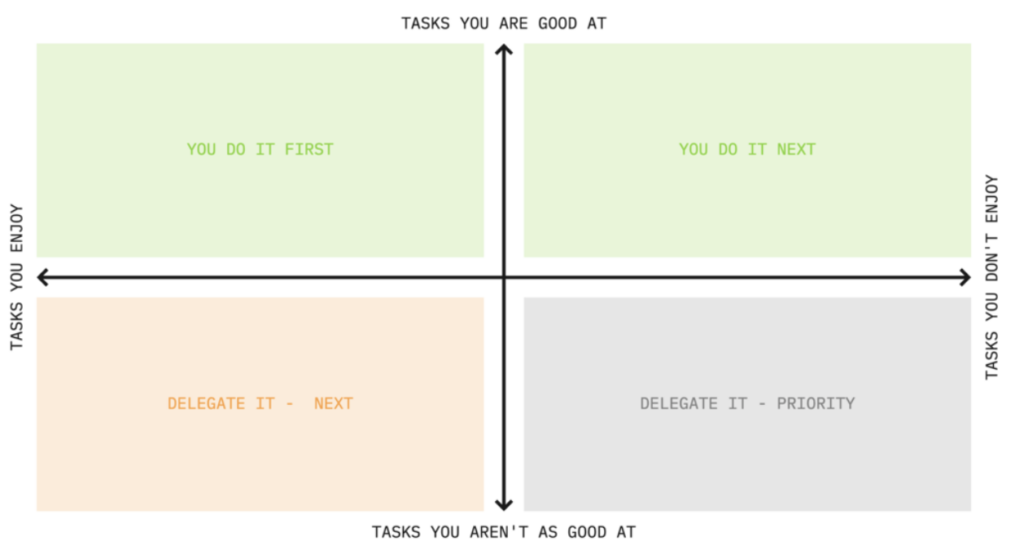Friday the 13th. Children. Your growing business. What do they all have in common? They can be so scary!
If you’re a parent, you’re probably familiar with the feeling of being afraid as your children grow up. The older they get, the less control you have on their safety and decision-making — it’s hard but you prepare them for life as best you can. Sure, they might stumble along the way but with the solid foundation they learned from you, they can overcome the obstacles. The same is true for your business.
When you started your business, you likely wore many hats. From marketing, to creating and collecting invoices, meeting with customers, implementing your service, paying your vendors, to completing the bookkeeping — you’ve probably done it all. It can be unsettling to let go of control but as your business grows, it’s a necessary part of the journey.
Here’s three steps you can take to prepare for the next phase of business growth.
- Work out what tasks you need to outsource/delegate
- Hire the right people
- Give them systems and processes to lean on
How to choose what tasks to delegate.
If you’ve always worked as a solopreneur, you’ll have been the one taking care of all the tasks for your business (except maybe the ones you outsourced like tax preparation or legal documentation). Now the business is growing, you need to ensure that you have enough time in your day to support that growth. After all, you are the lifeblood of your business.
To start, create a list of all the main tasks you do daily/weekly/monthly. Then, drop them into the matrix below.
- For tasks you are good at and you enjoy, put those in the upper left quadrant
- For tasks you are good at but don’t really enjoy, put those in the upper right quadrant
- For tasks you enjoy but you aren’t necessarily good at, put those in the bottom left quadrant
- And finally, for tasks you don’t enjoy and you aren’t as good at, put those in the bottom right quadrant
Now you’ve organized those tasks, we can start to see which ones should be kept with you versus the ones to be delegated.
- For tasks you’re both good at and you enjoy, continue to do those tasks
- For tasks you’re good at but you don’t necessarily enjoy, you will continue to complete those as long as time allows
- For tasks you don’t enjoy and you aren’t as good at, those will be the first you start to delegate
- For tasks you enjoy but aren’t as good at, those will be the next tasks you delegate if time/resources allows
So, now you have a handle on which tasks should be delegated — great job! Let’s move on to the next course of action: finding the right people to do the tasks.

Hire people you can depend on.
An entire blog post (or five) could be written on just this topic but let’s dive into the basics of how to approach this next step of business growth – hiring the right people. Since we already know the tasks we want to delegate, we can use those as the building blocks on knowing who to hire.
First, let’s look at if you need an employee or a contractor. Why is this important? An employee classification requires your business to have them on payroll which means withholding the appropriate amount of taxes, filing payroll returns to applicable taxing authorities and potentially other employment factors unique to your state. On the other hand, a contractor classification simply requires you to pay them their fee and potentially report the total amount paid on Form 1099-NEC at year-end.
The IRS has some rules and guidelines to help ensure the correct classification of employee versus contractor.
Factors that show the degree of control and independence:
Does your company control what the worker does and how they perform their job? If yes, it falls under employee classification
Are the business aspects of the worker’s job controlled by your business (how they are paid, if expenses are reimbursed, who provides tools/supplies etc)? If yes, it falls under employee classification
Are there written contracts or benefits typical of employees (pension plan, insurance, vacation)? Will the relationship continue and is the work performed a key aspect of your business? If yes, falls under employee classification
There’s no simple formula to determine employee vs contractor status, so if two of the above meet employee status and one meets contractor status, that doesn’t necessarily mean the worker should be an employee. Overall, it’s important to weigh all the factors and determine which weighs more heavily. Essentially, determine if your business has most of the control (employee status likely) or if the worker has most of the control (contractor status likely).
Once you know which type of worker you need, you can start to determine other specifics. Break your search out into two buckets to start—one for contractors and one for employees. Let’s start with contractors.
- Begin your search for reputable businesses who outsource their services. For example, a marketing firm could allocate one member of staff for 10 hours a week to focus on your business
- Connect with your network to see if anyone can recommend a contractor who has worked for them in the past
- Lastly, utilize resources such as Upwork to find help for specific tasks (like designing a logo) or a longer-term relationship (like recurring monthly invoicing help)
Next up: employees. Here are some questions to guide you towards the type of employee you want to hire and the type of workplace you want to bring them into.
- Do you want to offer remote work or will you require daily commutes to your office?
- Do you have a specific culture fit you want your new hire to meet?
- Do you know the necessary wage range to stay competitive with others in the market?
- Do you want to set up a health insurance package?
- Do you want your business to hire them or should you use a PEO (professional employer organization)?
Once you have these answers, you can create a job listing on sites like Indeed or LinkedIn. In addition, you can also search on those sites for qualified candidates and reach out to them directly. Or, if you have decided to use a professional employer organization (PEO), you can compare alternative PEOs and decide which one best suits your business’s needs.
Hiring can be an interesting process but if you remember 1) what tasks you want help with and 2) what kind of person/company you want to work for you, you can find the perfect match for yourself and your business.
Give them the systems and processes to lean on
So employees and/or contractors are successful in their roles, it’s important to have the appropriate systems and processes in place. Since you have been completing all the tasks up until this point, it’s highly likely the only system you have in place is stored safely in your own memory. For your new hires to succeed, it’s vital to document the systems and processes you use.
- Make a list of all systems you use and their purposes. Your workers can refer back to these as they become more familiar with everything.
- Note: This also might be a great time for you to do an audit of your systems. Are they right for your growing company? Are there better alternatives available? Do you need additional systems to support your new hires’ roles?
- Also, remember: version one is better than version none. Don’t get overwhelmed. Just start somewhere!
- Document your business processes e.g. how you do things. This will generate a clear path for your workers to follow to accomplish their designated tasks.
For #1, you might be using Xero for accounting and invoicing, Gusto for payroll, Plooto for bill pay, Box for document storage, Slack for daily internal communications, Zoom for video conferencing, and 1Password for password security. You can see how this many systems might be overwhelming for a new hire! So, having a list of each with brief descriptions helps a new hire manage all of these—especially at the beginning when they’re just starting to become familiar with what your business uses.
For #2, you might have a process documented for bill pay, one for invoicing clients, a process for recording client payments, a sales process, a process for submitting expense reimbursements, etc. They will be especially useful in the early stages of training your new hires and should ideally be available for your workers to refer back to at any point.
Enjoy the ride!
It may take a little time before you start to see the impact from new employees and/or contractors you’ve hired. Trust the process. Once they’ve had a chance to master their tasks and get familiar with your business, you’ll start to see time added back to your day. This will allow you to focus on the things you do best which, in turn, helps your business continue to grow! Remember, you didn’t build your business overnight and substantial growth changes aren’t going to happen overnight either. So, take a deep breath and remember you aren’t doing it alone: Revel is here for you too.
If you’re not sure your business can afford an employee, or how much you could afford to offer a prospective employee, Revel offers advisory sessions to go through the numbers with you. You can get in touch with us here.
You can also read more about making hiring decisions in an uncertain income environment, check out a past blog post here.





